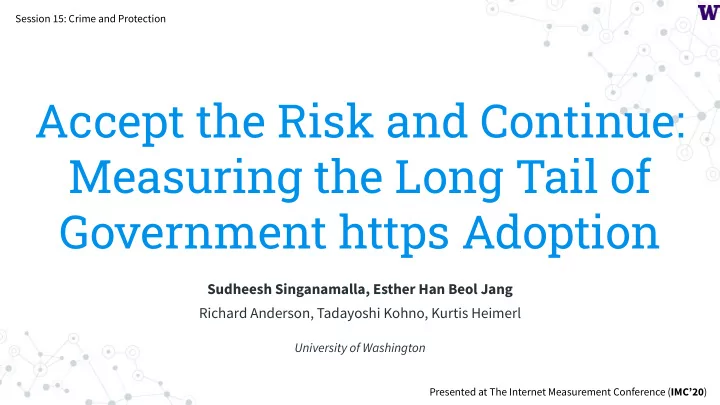

Session 15: Crime and Protection Accept the Risk and Continue: Measuring the Long Tail of Government https Adoption Sudheesh Singanamalla, Esther Han Beol Jang Richard Anderson, Tadayoshi Kohno, Kurtis Heimerl University of Washington Presented at The Internet Measurement Conference ( IMC’20 )
What is https ? And Why use it? Secure version of the http protocol - uses TLS for encryption and authentication - Default port: 443 Problems with http : - Lack of privacy/confidentiality : Users’ Internet traffic is visible and can be monitored by an attacker - Lack of authentication/identity: User has no way to validate that the response is actually from the server - Lack of integrity: User cannot validate that the message is not modified. 2
Motivation: https in The Internet Today Google’s HTTPs report 1 Measures the top 1 million websites on the Alexa top Million list. Published at USENIX Security 2017. Measuring the Tail Government websites are critical sites which may not show up in top million datasets. These could include national identity systems, citizen registers, tax, and health information. 3 1. Felt, Adrienne Porter, et al. "Measuring {HTTPS} Adoption on the Web." 26th USENIX Security Symposium (USENIX Security 17). 2017.
Popular Datasets & New Govt. Dataset 27,532 unique government Alexa Top Majestic Million Cisco Million Censys Big websites Query Million # Govt. Websites Majestic Million Cisco Million Tranco Million Top 1K 56 0 30 Top 10K 508 14 373 Top 100K 2538 433 2351 Top 1M 12445 ( 1.24% ) 9296 ( 0.93% ) 12293 ( 1.23% ) 4
Chasing the tail... - Crowdsource unique websites from 23 countries. 27,532 27,794 unique unique government government websites websites 5
Chasing the tail... - Crawl upto 7 levels of Depth. 843,561 27,794 hostnames which filter down to 301,219 unique government unique hostnames and 134,812 websites unique government websites 6
Chasing the tail... - Explicit whitelist and hand curation from 62 countries. 134,812 135,408 unique unique government government websites websites 7
Validating the Certificates - OpenSSL with the Apple Mac OS trust store imported - Download the entire certificate chain and validate 8
Results: At a glance Approx. 72% Government websites worldwide do not have https More than More than 11% 60% Websites result Serve content In an invalid https only using http connection 9
Validity by Certificate Authorities - Free CAs like Let’s Encrypt are the leading certificate providers - 80% validity - 20% invalidity - Hostname mismatch - Expiry - Self signed certs. Note : The CAs issuing certs differ by country. 10
Certificate Validity & Common Errors 11
Certificate Reuse - Incorrect use of wildcard certificates - *.portal.gov.bd applied on all *.gov.bd - Use of web server default certificates - “ localhost ” - “ example.com ” - Used across 58 hostnames across 24 countries. - Probably from a popular question-answer website - Allows the ability to intercept, decrypt and modify https traffic. - Indistinguishable if users add certificate to allowed browser exceptions
In Depth Case Studies: USA and ROK 1. Both countries have similar HDI scores and Internet adoption rates but have a differing https adoption - USA : 81.12% - ROK : 37.95% 2. Technical sophistication of both countries biases them towards higher https adoption numbers compared to the rest of the world. 3. ROK recently moved out of its own NPKI infrastructure to use global standards, and USA mandates government websites to have https . [Congress S.2749 116-192] Takeaway : https adoption in government websites is below expectations worldwide. 13
But Wait … What about Non-Gov Websites? Takeaway : Higher public cloud services usage and higher https adoption and validity in Non-Gov Websites. 14
Responsible Disclosures and Notifications - Controlled issuance of Government domains make it easier to reach the country government registrars - Higher response rate (~22%) compared to direct notification studies in the past (~5.8%) - 39 countries who proactively engaged . 15
Impact of Notifications - Scanned the reported websites 2 months later - Silently updated with no response - Unavailable websites back online - http -only traffic upgraded to https : - > 10% improvement in 62 countries - > 40% improvement in 7 countries. We weakly attribute this to the disclosure and notifications. 16
Future Work 1. S.2749 - DOTGOV Online Trust in Government Act of 2019 2. Encourage the usage of DNSSEC signed CAA records and HSTS Preloading 3. Encourage domain registrars to implement safeguards from domain names which could impersonate government domains. 4. Improve https adoption. 17
We would like to thank our shepherd Matthew Luckie and the anonymous reviewers for their valuable feedback which shaped the final paper. We also thank Dan Ports, Ming Liu, and the UW CSE Support team for their help in accessing the infrastructure to run the measurements. For their valuable feedback and discussions, we thank Chris Thompson from Google, and Matt Johnson and Spencer Sevilla from the ICTD Lab. We thank Tae Oon Jang for his knowledge and help in navigating Korean e-government resources.
Recommend
More recommend